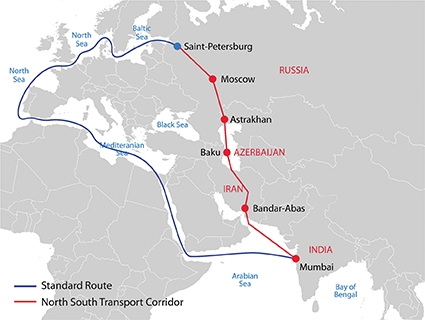International Transport Corridor (ITC) "North-South"
The International Transport Corridor (ITC) "North-South" is a multimodal transportation route for passengers and cargoes, running the total length from St. Petersburg to the Port of Mumbai (India).
Formation of the international transport corridor "North-South" was initiated by the Ministry of Transport of Russia in order to implement Russia's strategic partnership with the countries of the Caspian region.
The corridor is also expected to improve Russia's relations with the countries of the Persian Gulf and South Asia, as well as to ensure the development of transit Euro-Asian transportation by domestic transport communications.
The idea of the 7,000 km North-South transport corridor arose in 1993. However, only on September 12, 2000, did Russia, Iran and India sign a corresponding agreement, then ratified in 2002. In 2005, Azerbaijan joined the project followed by more than a dozen states joined, many of which claim a transit role.
The implementation of the idea stalled in connection with Western sanctions against Iran. With the lifting of sanctions from Tehran in January 2016, the project again acquired relevance.
A significant part of the North-South corridor runs along the railways of Russia, which, depending on the route, account for 33-53% of the total length of the overland part of the corridor.
The main direction for the Russian side within the framework of the ITC is Buslovskaya - St. Petersburg - Moscow - Ryazan - Kochetovka - Rtishchevo - Saratov - Volgograd - Astrakhan, with a length of 2,513 km.
ITC "North-South" in its southern part presents several routes for cargo transportation using railway transport: The Trans-Caspian route, using the Russian seaports of Astrakhan, Olya, and Makhachkala and the ports of Iran: Bender-Enzeli, Nouchekhr and Bender-Amirabad. The western branch of the corridor is a direct rail link through the Samur (Russia) -Yalama (Azerbaijan) border crossings, with further access to Iran's railway network through the Astara (Azerbaijan) - Astara (Iran) border crossing.
The eastern branch of the corridor is a direct rail service through Kazakhstan, Uzbekistan and Turkmenistan, with access to the Iranian railway network through the border crossings Serakhs (Turkmenia) - Serakhs (Iran) and Akheyla (Turkmenistan) - Ince Burun (Iran).
The main advantage of ITC "North-South" over other routes (in particular, before the sea route through the Suez Canal) is a reduction by two or more times the distance of transportation, as well as a reduction in the cost of transporting containers compared to the cost of transportation by sea route.
Of great importance for the development of the ITC North-South in the medium term will be the terms of commissioning of the new railway line Resht-Astara (Iran) -Astara (Azerbaijan), which is the last missing link in the direct rail route along the western branch of the ITC North-South.
Currently, within the framework of the interaction of Russia, Azerbaijan and Iran, work is underway to create a multi-modal route India-Iran-Azerbaijan-Russia, through which it is planned to organize the carriage of goods in containers on a regular basis. The route involves sea transportation of goods between the ports of India and Iran, the use of rail and road transport on the territory of Iran (due to the lack of a direct railway connection with Azerbaijan) and the subsequent delivery by the Azerbaijani and Russian railways to the final consumer.
Dimitri Dolaberidze











